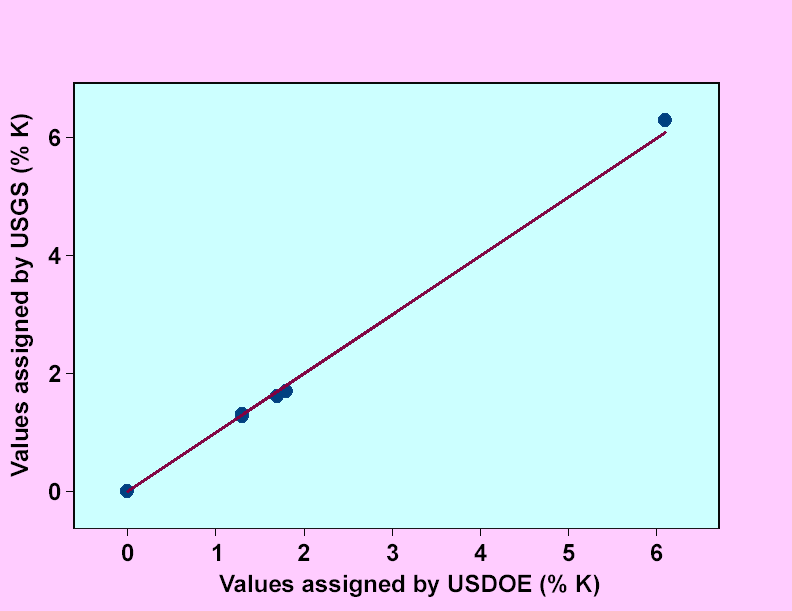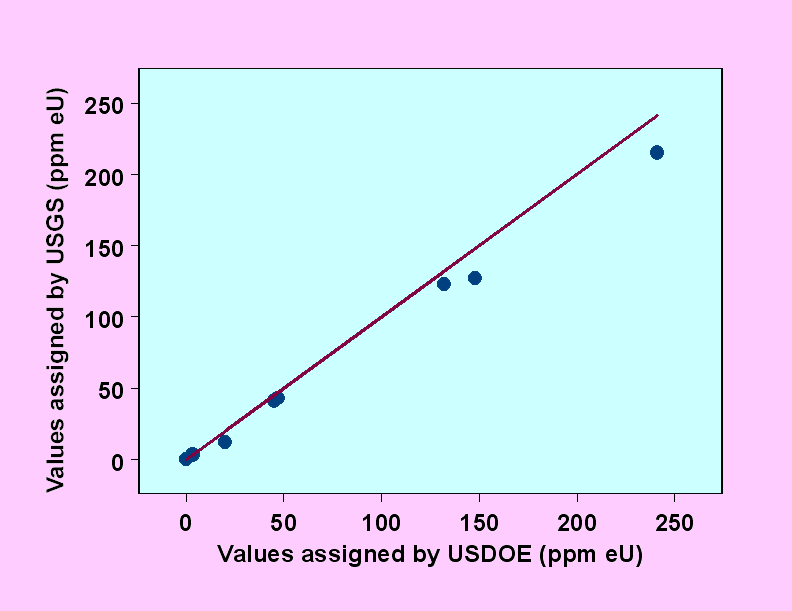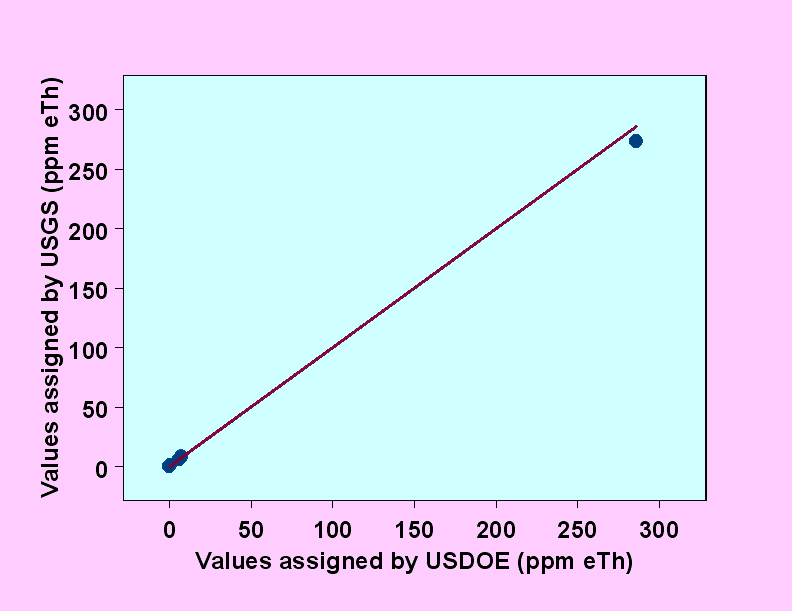
Samples of each of the calibration pads were collected by drilling 1 inch diameter holes around the peripheries of the concrete pads. In the case of the background pad (PB), the silica sand is loose in the container and an appropriate sample was drawn from the loose sand. The holes were drilled using a tungsten-carbide masonry bit that produced finely powdered samples. The samples were placed in plastic sample containers that were sealed with plastic electrical tape to prevent the escape of radon gas. Because these sample were aggregated from multiple holes, each about 15 cm deep, the samples should be representative of the pads. The potassium, uranium, and thorium concentrations were then measured using laboratory gamma-ray spectrometers. Snyder and Duval (2003) describe the laboratory spectrometers. Table 2 lists the mean values and standard deviations of repeated measurements of the samples.
Table 2 also lists the results of measurements made to estimate the radon emanation from the samples. These measurements were made by immediately measuring the concentrations following sealing of the sample containers. The assumption is made that all of the radon gas that could escape from the samples would do so during the handling and packaging process. The value obtained for the apparent uranium concentration was then used to estimate the fraction of radon emanation that escaped from the samples using equations derived from theoretical considerations. A spreadsheet is available with the calculations and equations as well as the file used with MathCad.
Because the samples are considered to be representative of the pads, the USGS has assigned these values to them. Table 3 lists comparisons of the values assigned by USDOE and those assigned by the USGS. The potassium values assigned by the USGS are in close agreement with the values assigned by USDOE. The uranium values assigned by the USGS are lower than those of USDOE and differ by an average of 15 percent. If we disregard the large difference associated with the thorium pad, the average difference is about 11 percent. The thorium values assigned by the USGS are greater than those of USDOE except for pad PT and differ by an average of about 9 percent (excluding the large percentage difference of pad PK). Figure 3 is a graph of the potassium concentrations versus the potassium values assigned by USDOE. Figure 4 shows a graph of the uranium concentrations versus the uranium values assigned by USDOE and figure 5 shows a graph of the thorium concentrations versus the thorium values assigned by USDOE. The potassium values assigned to the pads by the USGS are not significantly different from those assigned by USDOE. The uranium values assigned by USGS are consistently lower than those assigned by USDOE and the thorium values are generally higher.
Table 2. Concentrations of potassium, uranium, and thorium in samples taken from the calibration pads. The radon emanation fraction for the samples from pads PB, PK, and PT are not measurable using this technique because of low uranium concentration for PB and because of interference effects from potassium (PK) or thorium (PT). [Top of page]
|
Pad |
Potassium (% K) |
Uranium (ppm eU) |
Thorium (ppm eTh) |
Number of |
Radon | |||
|
Mean |
Std. Dev. |
Mean |
Std. Dev. |
Mean |
Std. Dev. |
Measurements |
Emanation | |
|
PB |
0.00 |
0.00 |
0.2 |
0.03 |
0.3 |
0.1 |
100 |
nd |
|
PK |
6.31 |
0.04 |
3.0 |
0.1 |
0.9 |
0.2 |
62 |
nd |
|
PPL |
1.28 |
0.02 |
40.7 |
0.6 |
5.7 |
0.2 |
59 |
0.14 |
|
PPH |
1.29 |
0.06 |
127 |
3 |
6.2 |
0.5 |
43 |
0.14 |
|
E2 |
1.6 |
0.1 |
217 |
5 |
7.8 |
0.7 |
38 |
0.10 |
|
PT |
1.7 |
0.1 |
13 |
1 |
271 |
2 |
45 |
nd |
|
NPH |
1.32 |
0.08 |
123 |
2 |
6.8 |
0.4 |
25 |
0.17 |
|
NPL |
1.28 |
0.09 |
41 |
3 |
5.6 |
0.5 |
53 |
0.15 |
Table 3. Comparisons of the values assigned by USDOE to those assigned by the USGS. The percentage differences are calculated with reference to the USDOE values.
|
Pad |
Potassium (% K) |
Uranium (ppm eU) |
Thorium (ppm eTh) |
|||||||||
|
USDOE |
USGS |
dK |
% |
USDOE |
USGS |
dU |
% |
USDOE |
USGS |
dTh |
% | |
|
PB |
0.0 |
0.0 |
0.0 |
0 |
0.0 |
0.2 |
0.2 |
- |
0.0 |
0.3 |
0.3 |
- |
|
PK |
6.1 |
6.31 |
0.21 |
3.4 |
3.5 |
3.0 |
-0.5 |
-14.3 |
0.4 |
0.9 |
0.5 |
125 |
|
PPL |
1.3 |
1.28 |
-0.02 |
-1.5 |
45 |
40.7 |
-4.3 |
-9.6 |
5.7 |
5.7 |
0.0 |
0 |
|
PPH |
1.3 |
1.29 |
-0.01 |
-0.8 |
148 |
127 |
-21 |
-14.2 |
5.8 |
6.2 |
0.4 |
6.9 |
|
E2 |
1.7 |
1.6 |
-0.1 |
-5.9 |
241 |
217 |
-24 |
-10 |
7.2 |
7.8 |
0.6 |
8.3 |
|
PT |
1.8 |
1.7 |
-0.1 |
-5.6 |
20 |
13 |
-7 |
-35 |
286 |
271 |
-15 |
-5.2 |
|
NPH |
1.3 |
1.32 |
0.02 |
1.5 |
132 |
123 |
-9 |
-6.8 |
5.9 |
6.8 |
0.9 |
15.3 |
|
NPL |
1.3 |
1.28 |
-0.02 |
-1.5 |
47 |
41 |
-6 |
-12.8 |
6.7 |
5.6 |
-1.1 |
16.4 |
Figure 3. Graph of potassium concentrations assigned to the calibration pads by the USGS plotted versus the concentrations assigned by USDOE. The line in the graph is the identity line where the values plot if equal. [Top of page]

Figure 4. Graph of uranium concentrations assigned to the calibration pads by the USGS plotted versus the concentrations assigned by USDOE. The line in the graph is the identity line where the values plot if equal. [Top of page]

Figure 5. Graph of thorium concentrations assigned to the calibration pads by the USGS plotted versus the concentrations assigned by USDOE. The line in the graph is the identity line where the values plot if equal. [Top of page]

[an error occurred while processing this directive]